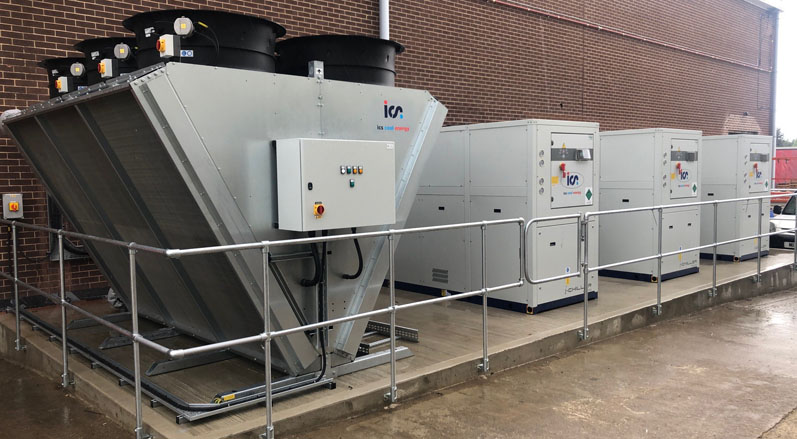Industrial applications depend on process temperature control systems to keep their operations and businesses running. Equipment that is improperly maintained can fail to provide the required level of efficiency, shortening its lifespan and increasing operating costs.
Planned preventive maintenance done by qualified engineers will give you the tools and support to keep the equipment in optimal shape, minimise energy consumption and limit downtime. The frequency of this should align with how often the equipment is used and how critical it is to operations.
Keep your chilled system maintained frequently
The expense of replacing parts that could have delivered a higher lifetime value, the time it takes to wait for the part and the subsequent multiple engineer call-outs, plus the cost to your business from downtime, will far outweigh the cost of a preventive maintenance plan.
Outsourcing your chiller plant maintenance will help to free up your internal resources, reduce your costs and keep your chiller performing at optimal conditions for longer.
With a service level tailored to your application and business needs, you can benefit from the assistance of an extensive team of qualified service technicians that provide 24/7, 365 emergency and planned support.
For your peace of mind, depend on technicians who are proficient in different makes and models of temperature control equipment and those that are also fully conversant with the current F-gas regulations safe handling of refrigerants, Control of Substances Hazardous to Health (COSHH) and Health and Safety Risk Assessment Regulations.
Do water quality checks and treatment
Efficiency, longevity and safe operation of closed-circuit process chillers is critical and should be top of mind for those who are responsible for them. Water treatment is a fundamental part of a chiller’s operation and maintenance, ensuring efficient and reliable operation.
Your chilled system water needs to be treated with the correct dose of high-quality inhibited glycol to protect from freezing, bacteria build-up and corrosion. Taking samples of your system water as part of your planned preventative maintenance programme and running pH tests will help you to determine the quality.

If the water samples fall outside of the recommended pH level, a water treatment programme can be followed to correct the problem. This could save you the cost of a breakdown and replacement of equipment and pipework.
Should your systems show signs of increased suspended solids, corrosion or other debris, several devices can be used to remove such contamination. This includes strainers, filters, magnetic filters, dirt separators, combined air and dirt separators as well as commonly found side stream filtration.
Several systems have side-stream filtration included at the design stage to safeguard some of these issues. Such equipment is simple easy to install and has a simple process of solids removal.
Side stream filters are designed to constantly pass 5–15% of the circulating water through a filter housing, resulting in the total system volume being filtered 2–3 times every 24 hours.
Upgrade your chiller to a high-efficiency and high-performance unit
The average lifespan of a chiller is dependent on how heavily it’s used and how well it is maintained. Manufacturing process chillers, for example, tend to be used much more heavily than chillers for comfort purposes.
As a guiding principle, if your process cooling system is more than 8–10 years old, it’s worth considering upgrading to the latest high-performance technologies, such as the i-Chiller, which is designed with process applications in mind from the ground up.
This move can result in savings on your energy costs, maintenance costs and provide greater reassurance with a new 5-year warranty.
Relocate your chiller plant externally and use a free cooling coil
As autumn and winter approach and the ambient temperature drops, preparing to capitalise on free cooling could save you up to 70% on your energy costs.
As soon as the ambient temperature drops 1 °C below your desired operating temperature, you can utilise partial free cooling to cool your process.

Free cooling is a concrete solution that will reduce mechanical energy consumption, lower the carbon footprint, reduce load on mechanical parts and therefore reduce maintenance cost and extend life of your cooling equipment.
Replace cooling towers
Cooling towers are expensive to run, maintain and waste a lot of water. To put this in monetary terms, for every £39k spent running a cooling tower, you would expect to spend £10k running an adiabatic cooler — saving approximately 75%.
And if the saving of money alone isn’t enough, you could seriously boost your environmental credentials too.
Providing significant savings on water usage, they require significantly less maintenance and operational costs and no ongoing chemical treatment or registration with local authorities, while operating at optimal efficiency in high ambient temperatures.
For every 70 buckets of water used by a cooling tower, you would expect to use one with an adiabatic cooler — saving you 93% on your water costs and conserving a vital resource. Replacing your cooling towers will save you this cost annually and reduce your health and safety risks.
